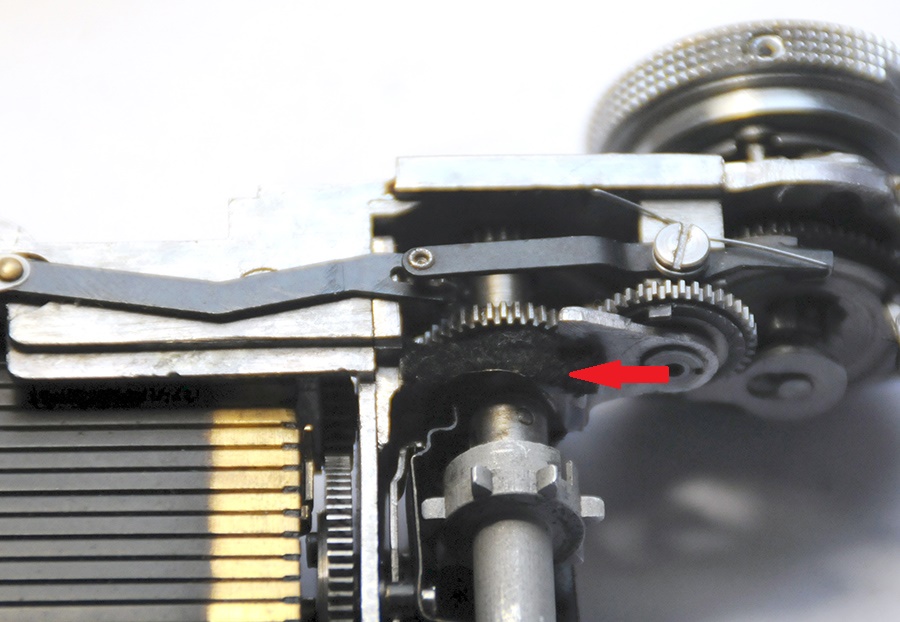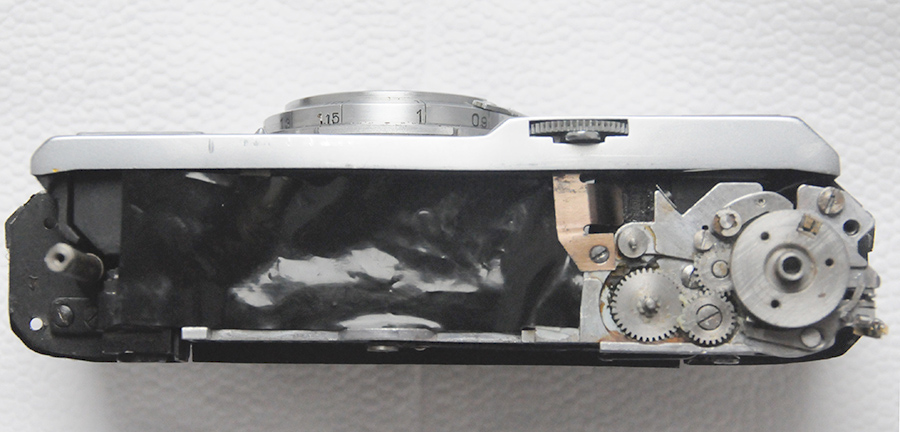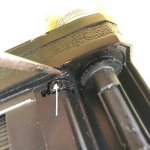Huss
Veteran
Just finished my first roll in this camera. Exposures/shutter timing are great. Focus is spot on. Lens excellent. But I am getting a light leak on about 50% of the film, coming through the sprocket area on the bottom left corner. See below.
Note - the camera is always in it's half case so it cannot come in through the bottom. It looks like it is coming in through the area by the VF - so I'm guessing the exposed seam just below the VF where the leather case is cut down to fit.
Ideas?



Note - the camera is always in it's half case so it cannot come in through the bottom. It looks like it is coming in through the area by the VF - so I'm guessing the exposed seam just below the VF where the leather case is cut down to fit.
Ideas?



Mark Wood
Well-known
Very common and almost certainly the baffle behind the rangefinder prism:
http://www3.telus.net/public/rpnchbck/fixing light leaks.html
with light then coming through the sprocket drive area. (Lay the film across the gate and the streak will probably line up with the appropriate place.) Other people's experiences of sorting this one out may differ but I've found it impossible to fix in two cameras, the fit of the components under the top casting being so poor. If you shine a bright torch through the small rangefinder window in a dark room, you will see a pin point of light in the area near the sprocket drive - wind and fire the shutter a few times and retry this though, as it won't happen every time. It's more like it was a feature that was built into the later Kievs I'm afraid and that's a very late one.
On colour negative film, the streak on the final prints/scans would be orange if a leak from the back was to blame. That's a white streak, so it's a light leak on the emulsion side of the film. The fogging doesn't happen on the frame that's lined up with the film gate, it's on the previous exposure that's partially wound onto the take-up spool, if that makes sense!
http://www3.telus.net/public/rpnchbck/fixing light leaks.html
with light then coming through the sprocket drive area. (Lay the film across the gate and the streak will probably line up with the appropriate place.) Other people's experiences of sorting this one out may differ but I've found it impossible to fix in two cameras, the fit of the components under the top casting being so poor. If you shine a bright torch through the small rangefinder window in a dark room, you will see a pin point of light in the area near the sprocket drive - wind and fire the shutter a few times and retry this though, as it won't happen every time. It's more like it was a feature that was built into the later Kievs I'm afraid and that's a very late one.
On colour negative film, the streak on the final prints/scans would be orange if a leak from the back was to blame. That's a white streak, so it's a light leak on the emulsion side of the film. The fogging doesn't happen on the frame that's lined up with the film gate, it's on the previous exposure that's partially wound onto the take-up spool, if that makes sense!
Huss
Veteran
Huss
Veteran
ColSebastianMoran
( IRL Richard Karash )
Huss, why is the leak at a different spot in the two shots you posted?
TenEleven
Well-known
Huss, why is the leak at a different spot in the two shots you posted?
The position seems similar enough to me and from my experience the exact position of both flare and light leaks depends on the angle and intensity of the incoming light.
Ko.Fe.
Lenses 35/21 Gears 46/20
I would start with fresh light seal on the body Chanel at perimeter of removable back.
Black wool thread is what was and is in use.
Black wool thread is what was and is in use.
Huss
Veteran
Huss, why is the leak at a different spot in the two shots you posted?
the first pic is the very first on the roll which is y it is in a slightly different position. but they all are in that area.
Huss
Veteran
I would start with fresh light seal on the body Chanel at perimeter of removable back.
Black wool thread is what was and is in use.
I can see the light leak at the top of the sprocket shaft inside the body. so that would not help. Mark was correct with his explanation.
Mark Wood
Well-known
Yes, that's exactly where it comes from with three Kiev bodies I have. It does seem to originate from a poor light seal/baffle behind the rangefinder prism but the problem with the cameras I have is that the fit of all of the parts in that region of the top of the camera is so poor, that there isn't really any chance of a new baffle behind the prism stopping every light leak. The poor quality of the parts in some of these cameras really has to be seen to be believed. Light leaks from the body channel tend to spread much further into the sprocket region of the film and would show up as orange on colour negative film, as the light has to come through the film base to reach the emulsion - I've seen that problem too but it's much easier to resolve.
I've tried all of the other suggestions in the article on the Kiev survival site but sadly, all to no avail, I'm afraid. I think there's a good reason why so many late models of these cameras turn up in almost mint condition, as they were probably never usable from the day they left the factory. (The 1950s/60s ones are a different matter altogether and some of those from the early-mid 1970s don't seem too bad either.)
It's probably best to look for one that's been well used!
I've tried all of the other suggestions in the article on the Kiev survival site but sadly, all to no avail, I'm afraid. I think there's a good reason why so many late models of these cameras turn up in almost mint condition, as they were probably never usable from the day they left the factory. (The 1950s/60s ones are a different matter altogether and some of those from the early-mid 1970s don't seem too bad either.)
It's probably best to look for one that's been well used!
Mark Wood
Well-known
Here's the same problem from a 1975 Kiev 4a. (Taken on slide film and scanned very badly!) That camera probably now has more bits of foam and black plastic sheeting stuffed in it than it has original metalwork but it still has this light leak - sometimes...
Attachments
Mark Wood
Well-known
Steve M.
Veteran
If that's the case, it's an easy fix Mark. Just put a drop of white glue in the hole and give it a dab w/ a black marker. If you have a bit of acrylic or other paint then it's a one step operation (just dab a little paint into the hole opening).
Brambling
Well-known
Dear friends, the figured light-shielding gasket is missing or incorrectly installed in these chambers (item 11, figure 27)


Huss
Veteran
Dear friends, the figured light-shielding gasket is missing or incorrectly installed in these chambers (item 11, figure 27)

Thank you for this information. Any idea where to get that part? Or craft something myself?
Ko.Fe.
Lenses 35/21 Gears 46/20
I can see the light leak at the top of the sprocket shaft inside the body. so that would not help. Mark was correct with his explanation.
Explanation means nothing until you will fix the problem.
I cured my 4am leaks starting from where I mentioned.
And then I applied some other patches. But if you think what Mark's explanation is correct, I'm done here.
farlymac
PF McFarland
I'd try either some gaffers or electrical tape to cover the suspect area. Looks like it will clear the film movement.
PF
PF
Brambling
Well-known
Thank you for this information. Any idea where to get that part? Or craft something myself?
you can do it yourself.
for production and installation it is necessary to disconnect slightly the shutter from the case.
There are two pads - round with a cut side and curved shaped. The round is usually not lost, the curved figured can be lost or installed incorrectly.
The figured can be made most of any dense black material thin, it is good to use copper or brass plate - it is more rigid.

Also, if you have already removed the cover, it is good to install such a gasket.

and change/add a string seal in the lid.
unfortunately, now I have disassembled Kiev is not for photography and measurements of curly pads. I recommend buying a cheap donor.
the photos are taken here from my club mates. http://rangefinder.ru/club/viewtopic.php?f=5&t=14687&hilit=киев
Oh, the translation is completely different, I hope you understand me.
Huss
Veteran
If that's the case, it's an easy fix Mark. Just put a drop of white glue in the hole and give it a dab w/ a black marker. If you have a bit of acrylic or other paint then it's a one step operation (just dab a little paint into the hole opening).
I just filled those holes w/ black rtv sealant. Seems like no light is coming through them now but my room was not pitch black just yet. The fact that my leaks were directly on the film's sprocket hole areas makes me hopeful.
Aside from the light leak this camera seems a-ok with a very nice lens that makes sweet pics:

(hey how come she gets to use an M7 while I have to tool around a Kiev?!
farlymac
PF McFarland
I was going to take you up on your original offer, Huss, but I'm glad you solved the problem instead.
I've noticed this with more than one FED camera, and have seen the light bouncing around before. These small kinds of leaks can sometimes be difficult to pin down as to where it is coming from, but you've shown that by studying the pattern and location of the leak, it can be traced to the source much easier.
Good luck on the RTV sealant. I'd be leery of it out-gassing onto the lens.
PF
I've noticed this with more than one FED camera, and have seen the light bouncing around before. These small kinds of leaks can sometimes be difficult to pin down as to where it is coming from, but you've shown that by studying the pattern and location of the leak, it can be traced to the source much easier.
Good luck on the RTV sealant. I'd be leery of it out-gassing onto the lens.
PF
Share:
-
This site uses cookies to help personalise content, tailor your experience and to keep you logged in if you register.
By continuing to use this site, you are consenting to our use of cookies.




